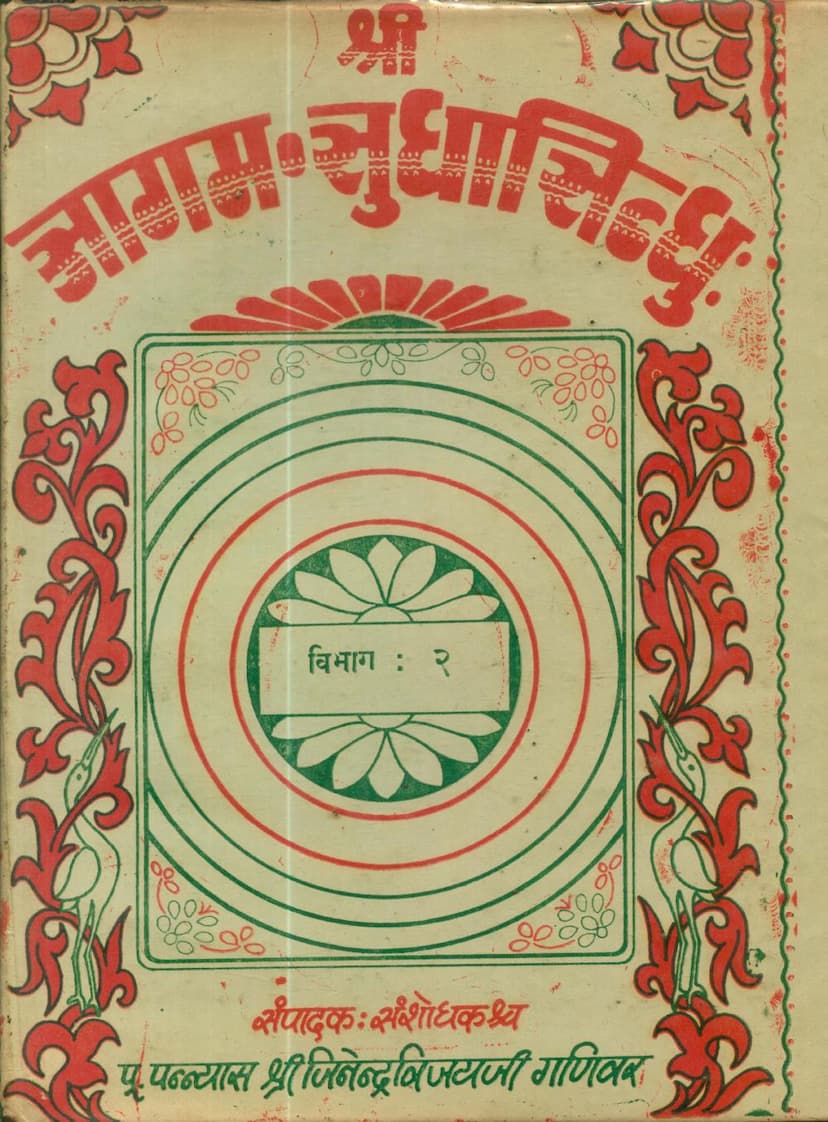Agam Sudha Sindhu Part 02
Added to library: September 1, 2025

Summary
The provided text is the second part of a Jain text titled "Agam Sudha Sindhu," authored by Jinendravijay Gani and published by Harshpushpamrut Jain Granthmala. This summary will cover the key aspects presented in the text, focusing on the editorial and introductory sections, as well as the chapter outlines and textual content.
Book Title: Agam Sudha Sindhu Part 02 Author: Jinendravijay Gani Publisher: Harshpushpamrut Jain Granthmala
Overview:
The text is a compilation and scholarly presentation of Jain Agamas, specifically focusing on the Shrimad Bhagavati Sutra, also known as Shrimad Vyakhya Pragapti Sutra, which was originally composed by the fifth Ganadhar, Shridharma Swami. The second part (Dwitiyo Vibhagah) of "Agam Sudha Sindhu" covers the first 12 Shatakas (centuries) of this significant Agama.
Editorial and Publisher's Notes:
- Editor/Researcher: The work is credited to Panayas Shri Jinendravijayji Ganivar, a disciple of Pujyacharya Dev Shrimad Vijayamrut Surishwarji. The editorial notes express gratitude for the opportunity to present this sacred knowledge.
- Publisher: Harshpushpamrut Jain Granthmala, located in Lakhwaval, Shantipuri (Saurashtra), Gujarat, is the publisher. The publication details indicate it was released in the Jain Samvat year 2502, Vikram Samvat 2032, and the Gregorian year 1976.
- Inspiration: The editorial emphasizes the importance of Jinavani (the teachings of the Jinas) as the foundation of the Jain religion, describing it as the source of right faith, knowledge, and conduct. It highlights the role of the Agamas, particularly the 45 Mool Agamas and their "Panchangi" (five limbs or aspects of study). The text also references the transformative power of Jinavani through the example of Chilatiputra.
- Scope of the Work: The editorial explains that the 45 Mool Agamas are divided into 6 sections: Anga Sutras (11), Upanga Sutras (12), Panna Sutras (10), Cheda Sutras (6), Mool Sutras (4), and Choolika Sutras (2). The current project aims to publish these 45 Mool Agamas in 14 divisions through careful editing and research to facilitate their study. This second part specifically contains the first 12 Shatakas of the Bhagavati Sutra.
- Sources: The editing and compilation of the Bhagavati Sutra in this volume have utilized various published editions and commentaries, including those from Dhanpat Singhji, Acharya Sagar Anand Surishwarji, Acharya Abhaydev Surishwarji, Acharya Danashekhar Surishwarji, and Pt. Hiralal Hansraj. Gratitude is expressed to these sources.
- Purpose: The publication aims to provide a comprehensive and accessible version of the Agamas for the benefit of the Jain community, particularly Muni Bhagwants (Jain monks) who are the primary custodians and scholars of these texts. The hope is that this compilation will encourage deeper study and memorization of the Agamic scriptures, thereby strengthening Jain knowledge and practice.
Textual Content and Structure:
The bulk of the provided text consists of the detailed chapter listings (Anukramanika) and the actual scriptural text, primarily in Prakrit/Ardhamagadhi languages, with page numbers and verse/section references.
- Content Focus: The text is primarily the Shrimad Bhagavati Sutra, covering discussions on various philosophical and practical aspects of Jainism. Based on the chapter headings (Anukramanika), the content delves into topics such as:
- Movement and Causation: (e.g., "Chalana," "Dukh Vishay") discussing movement, cause and effect, and the nature of suffering.
- Cosmology and Existence: Topics like "Prakriti," "Prithvi," "Viman," "Lokpal," and various realms of existence are mentioned.
- Knowledge and Perception: Discussions related to senses ("Indriya"), knowledge types, and the nature of perception are likely included.
- Karma and Rebirth: Concepts of "Karma," "Bandh" (bondage), "Udaya" (manifestation), and "Nirjara" (eradication of karma) are fundamental.
- Ethical Conduct and Vows: While not explicitly detailed in the headings, the context of Jain scriptures implies discussions on right conduct, vows, and asceticism ("Vairagya," "Sanyam").
- Specific Subjects: The chapter titles reveal specific discussions on topics like "Lakshana" (characteristics), "Pudgal" (matter), "Jiva" (soul), "Ahar" (food/nourishment), "Samaya" (time), "Karma," "Lesya" (complexion of the soul), "Drishti" (viewpoint), "Anuprerana" (motivation), and many more specific terms and concepts within Jain philosophy.
- Debates and Dialogues: The structure suggests the content is often in the form of dialogues, likely between Lord Mahavir and his chief disciple, Lord Gautam Swami, or other disciples, discussing complex spiritual and philosophical issues.
- Detailed Listings: The "Anukramanika" (Index) provides a chapter-by-chapter breakdown, listing the Shataka (Century), the chapter number (Uddeshak), and the topic covered. This detailed index allows for easy navigation of the vast content within the Bhagavati Sutra.
Key Jain Concepts alluded to in the editorial and chapter titles:
- Agamas: The sacred scriptures of Jainism.
- Bhagavati Sutra/Vyakhya Pragapti Sutra: A principal text detailing spiritual discourse and philosophy.
- Panchangi: The five aspects of studying the Agamas: Vachana (recitation), Prichhana (inquiry), Paravartana (recollection), Anupreksha (contemplation), and Dharmakatha (religious discourse).
- Gnanachara, Darshanachara, Charitraachara, Tapachara, Viryachara: The five types of conduct that lead to liberation.
- Samyakdarshan, Samyag-gnan, Samyakcharitra: The three jewels of Jainism leading to liberation.
- Four Pillars of Jainism: Sadhu, Sadhvi, Shravak, Shravika (monks, nuns, male householders, female householders).
- The 45 Mool Agamas: The foundational scriptures.
- The concept of "Pudgala": Matter, its qualities and transformations.
- Karma: The principle of action and consequence, a central tenet of Jainism.
- The nature of the Soul (Jiva): Its characteristics, bondage, and liberation.
In essence, "Agam Sudha Sindhu Part 02" is a scholarly endeavor to preserve and disseminate the profound teachings of the Bhagavati Sutra, making it accessible to a wider audience interested in Jain philosophy and practice. The detailed editorial notes underscore the significance of the Agamas in guiding spiritual progress and the commitment of the publisher and author to this noble cause.